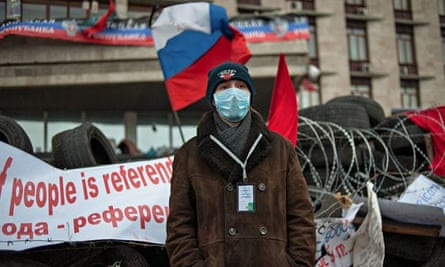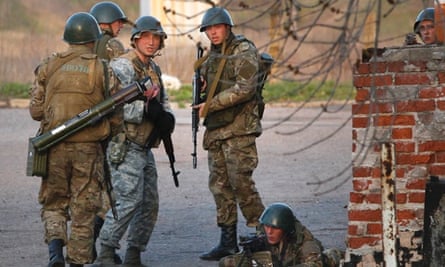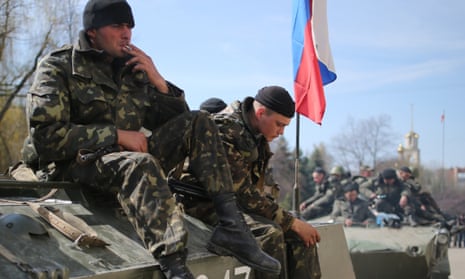Pro-Russian militias and crowds of unarmed locals have been confronting Ukrainian troops trying to reclaim government buildings and territory in eastern Ukraine. Here's a city-by-city guide to the clashes. Updated on 16 April 2014.
This article includes content provided by Google. We ask for your permission before anything is loaded, as they may be using cookies and other technologies. To view this content, click 'Allow and continue'.
Slavyansk
Armed gunmen raided the Slavyansk police station on 12 April and proceeded to occupy government buildings, pledging allegiance to the "People's Republic". Local "self-defense" forces have built checkpoints and barricades around the town. On Sunday 13 April an abortive Ukrainian security operation resulted in the reported death of one Ukrainian officer, while Russian media reported one militant killed as well. Armed gunmen have defied several orders to surrender or face repercussions. On Wednesday 16 April locals and militants surrounded a convoy of six Ukrainian armored vehicles, disarmed the troops, and paraded the vehicles through town. The location of the disarmed soldiers – some of whom may have defected – remains unknown as of Wednesday evening.
Some of the armed men admitted to the Guardian that they came from Crimea, and the sentiment among locals was both celebratory and suspicious, Luke Harding reports: "Slavyansk residents who had been fearing an imminent attack from Ukrainian forces had a moment of cognitive dissonance. … Teenage girls posed coquettishly with the men in balaclavas. Small children lined up too. Someone put a cuddly toy next to a gun barrel."
Donetsk
In the largest city in this mining and industrial region, local government buildings – including the equivalent to city hall – have been occupied since 6 April, and militia declared the "Donetsk People's Republic" and began fortifying with barricades and sniper posts. Militia raided the police station and clashes between pro-Russian and pro-Ukraine protesters have left at least one person dead and injured at least two dozen. The Guardian's Alec Luhn reported that tensions are running high between pro-Ukrainian and pro-Russian supporters, and that the latter are consolidating control.

Coal miners have joined well-armed gunmen in the anti-Kiev camp, and the mayor, the oligarch Rinat Akhmetov, has reportedly mediated negotiations between the protesters and the Kiev-appointed regional governor. Demonstrators have set up a "people's council" and building tire barricades in the city's central square and shouting "Glory to Donbass" – the historical name for the region.
But on 16 April, men with fatigues and automatic weapons took control of his office, the first major action in weeks. Protesters have demanded greater independence from Kiev, some have called for a referendum and Russian peacekeepers, but there have been pro-Kiev protests as well.
Kramatorsk
Since 12 April, men with automatic weapons have held the police headquarters and barricaded checkpoints around the city. After a tense Tuesday following the Ukrainian army's recapture of an airfield outside the city, militia drove captured Ukrainian APCs through the city on Wednesday, and 14 APCs were blockaded at the nearby village of Pcholkino. (Those soldiers did not disarm as demanded, but could not advance.)
Airfield at Kramatorsk
Near Kramatorsk, the Ukrainian "anti-terrorist" operation made its tentative first step when forces recaptured an airfield from militia on Tuesday 15 April.

Ukrainian forces unloaded off of helicopters and vehicles reportedly began positioning themselves in the area, and the Guardian confirmed only two minor injuries from a confrontation between the military and civilians.
Luhansk
In Luhansk (which is in its own region, and not that of Donetsk), a group calling itself "the army of the south-east" seized the city's security headquarters on 6 April. The armed men included members of the well-armed, well-disciplined and now-disbanded Berkut riot police, who fought against protesters in Kiev and who participated in the seizure of Crimea.
Protesters have demanded a referendum, greater independence from Kiev, and one told the Guardian: "We call on Russia to come and save us." Police had managed to clear the government office on 12 April.
Horlivka

On Monday 14 April, poorly armed protesters stormed the police headquarters and badly beat the city police chief who had vowed to stay there. "Little green men" – the moniker for well-armed militiamen widely alleged to be co-ordinating with Russian military and security services – were "nowhere to be seen", according to the Guardian's Alec Luhn.
Druzhkivka
At Druzhkivka, a government building was reported seized over the weekend of 13-14 April, and protesters have kept a steady presence on the streets since then.
Kharkiv

More populous and farther west than other cities, and with stronger pro-Kiev sentiment, Kharkiv has seen clashing protests between pro-Russia and pro-Kiev groups since 6 April. Pro-Russian forces occupied and withdrew from government buildings several times, as police were able to evict them. Protests have found renewed life over the weekend, however, pro-Russian groups have entrenched.
Mariupol
On 13 April a pro-Russian group took over the mayor's office and barricaded the building, declaring a new, un-elected mayor for the large city. Late on 16 April a crowd lay siege to a military outpost in the city of Mariupol late Wednesday, and shots were fired. Local news outlets reported multiple injuries, but the details were not confirmed.
Yenakiyeve
Militants have hoisted Russian flags over government buildings and protesters are on the streets, but ex-president Viktor Yanukovych's hometown has stayed relatively quiet.

Comments (…)
Sign in or create your Guardian account to join the discussion